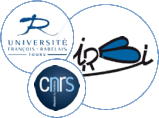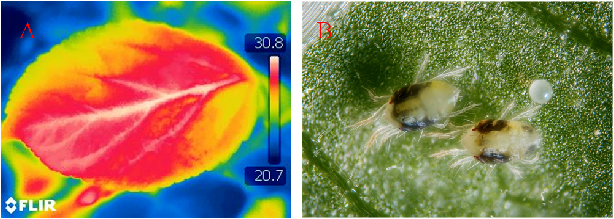








Institut de Recherche sur la Biologie de l'Insecte
UMR 7261 Faculté des Sciences et Techniques
Avenue Monge, Parc Grandmont
37200 TOURS (France)


Temperature is one of the key variables affecting the performance and fitness of ectotherms but the study of its impact on organisms can be challenging (Huey & Kingsolver 1993). In fact, the representativeness of global climate is questioned for a high diversity of organisms which experience microclimates that can greatly deviate from global and local climates (Gates 1980; Pincebourde et al. 2007). In addition, microclimates can be highly heterogeneous in space such that the spatial variations challenge the predicted amplitude of (micro-

PhD Project
Several studies addressed those microclimatic concerns at the leaf or plant scale, but a very few tried to integrate such mechanisms at a global scale.
Based on the Malus pumila (Rosaceae)/Aphis pomi (Aphididae) biological model, the
overall aim of my PhD project is (i) to characterize the interaction between global
climate and leaf surface microclimate in a latitudinal gradient (from south of France
to Belgium) and (ii) to assess the consequences on arthropods living at the leaf
surface in terms of thermal sensitivity. Implying field experiments, biophysical
modeling (thermal budget), plant and animal ecophysiology, and bioclimatology, this
project is at the crossroad between applied and basic ecology. It is coupled with
the “MicroCliMite” ANR project (S. Pincebourde) “Cascading from global to micro-
I started to work on this thematic during my Master degree where I studied the impact of climate on the leaf microclimate heterogeneity and its consequences for the thermoregulation abilities of a phytophagous spider mite (Tetranychus urticae, Tetranychidae) at the leaf surface.

Fig.1 (A) Infrared image of an apple leaf surface taken in the field under full sunlight (photo credit: Sylvain Pincebourde) and (B) T. urticae at the leaf surface (photo credit: Gilles San Martin).

References
Gates, D. M. 1980. Biophysical ecology. Dover Publications Inc., 635pp.
Grant, B. W., and W. P. Porter. 1992. Modeling global microclimatic constraints on
ectotherm energy budgets. American zoologist 32:154-
Huey, R. B. and J. G. Kingsolver. 1993. Evolution of resistance to high temperature
in ectotherms. The American naturalist 142:21-
Pincebourde, S., H. Sinoquet, D. Combes, and J. Casas. 2007. Regional climate modulates
the canopy mosaic of favourable and risky microclimates for insects. Journal of Animal
Ecology 76:424-
Scherrer, D. and C. Korner. 2010. Infra-
Biogeography of the leaf microclimate : mechanisms and consequences on insect plant interactions
Keywords :
Biogeography
Biophysics
biotic interactions
energy budget microclimate
